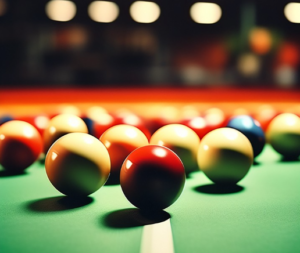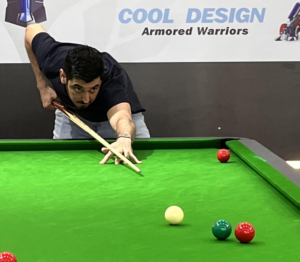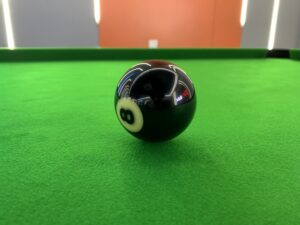“The highest realm of billiards isn’t about precise aiming, but controlling the cue ball’s trajectory.”
Many billiards enthusiasts fall into a common misconception when learning techniques: they believe the core of the game is “hitting straight” or “aiming accurately.” However, if you observe professional matches closely, you’ll notice their cues don’t always point directly at the pocket, their cue ball paths aren’t always straight, and their pursuit of precision pales in comparison to their obsession with cue ball control.

What Is the True Goal of Billiards?
The core objective of modern billiards can be distilled to one thing: controlling the cue ball’s landing spot. The cue ball’s movement route is the very soul of the sport. How far a player can go doesn’t depend on their ability to make shots, but on their precision in placing the cue ball exactly where they want it.
Why is cue ball control more critical than making shots? Consider this:
– Hitting accurately without controlling the cue ball is like playing a one-off game—each made shot is isolated, lacking continuity and the power to dominate the match.
– Controlling the cue ball means planning the next move (or even several moves ahead), keeping yourself in an active position.
In other words, the biggest gap between professionals and amateurs isn’t their shot success rate, but their **cue ball control proficiency.

How to Master Cue Ball Control?
Controlling the cue ball’s trajectory requires training three key capabilities:
1. Strike Techniques to Constrain the Cue Ball’s Path
Many think the core of striking is “keeping the cue straight,” but the cue’s direction doesn’t dictate the cue ball’s final trajectory. Factors influencing its path include: hitting point, force, lateral momentum, cue deflection, and tip contact pattern.
Professional players aim to make the cue ball’s path stable and predictable, not random. For example:
– Why do pros prefer using mid-right spin over hitting dead center? Because it reduces deflection and stabilizes the trajectory.
– Why don’t masters rely solely on hitting the cue ball’s bottom for a draw shot? Because cue deflection affects the actual hitting point, requiring precise control.
To improve control, learn techniques that constrain the cue ball’s path. Focus on finding the most stable stroke, rather than chasing “the strongest draw” or “the most exaggerated spin.”
2. Predicting the Cue Ball’s Movement
Have you ever thought the cue ball would go one way, only to see it deviate completely? That’s a lack of predictive ability.
Pros don’t develop this intuition naturally—they build it through relentless observation, summarization, and experimentation. For instance:
– They can precisely calculate the cue ball’s rebound angle off the cushion, not leaving it to chance.
– They “visualize” the entire trajectory before striking, instead of guessing afterward.
The key to training prediction is observation: after each shot, note whether the cue ball’s actual path matches your prediction. Where was the error? Was it a hitting point or force issue? Constantly refining this will sharpen your prediction.
3. Repeatable Consistency
Billiards isn’t decided by a single shot—it’s a long, high-intensity battle. Even with excellent control and prediction skills, inconsistent performance under pressure will cost you matches.
Professionals excel not only in technique but also in focus and stability. They know how to manage energy and maintain precision under stress. If your performance fluctuates wildly, your attention management needs work.
During training, practice not just techniques but also mental stability—learn to sustain your peak state over time.

Conclusion: How to Train?
1. Practice fixed-point cue ball trajectories: Choose a force and hitting point, strike the cue ball alone, observe its path. Master consistency before adding object balls.
2. Train with positioning goals: Don’t just practice accuracy—before each shot, set a target for the cue ball’s landing spot and aim to reach it consistently.
3. Record and analyze errors: After each session, review cue ball paths, identify deviations, and find improvements.
4. Observe cue ball movement in matches: Instead of fixating on whether the object ball goes in, focus on the cue ball’s trajectory and whether it matches your prediction.
5. Choose the right table: Beyond force and hitting points, table quality impacts trajectory significantly. Opt for mid-to-high-end tables like Spike, which uses high-density bluestone for a perfectly flat surface and self-developed baize that’s smooth and non-sticky.

Billiards isn’t a game of making shots—it’s a game of control. Mastering the cue ball’s path is the only shortcut to excellence.
